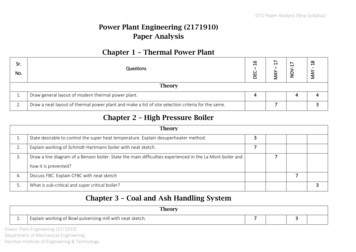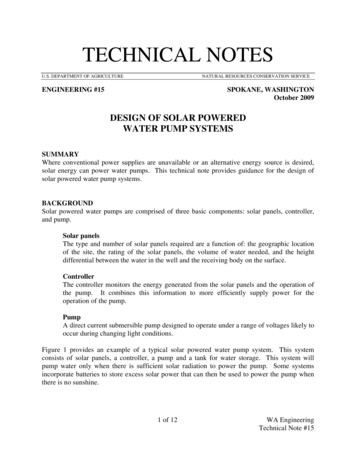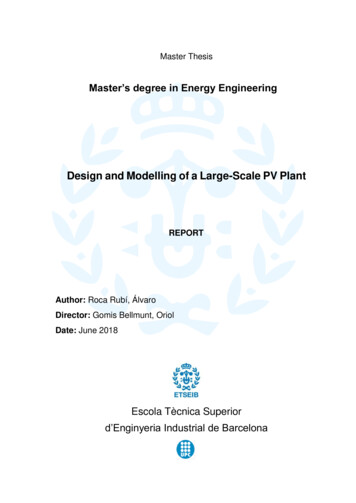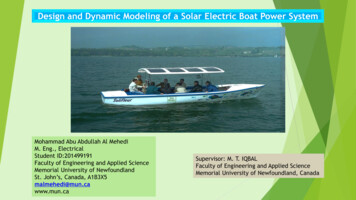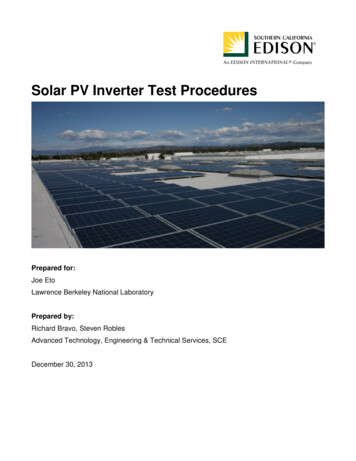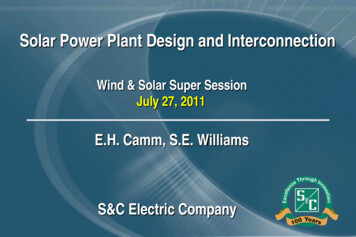
Transcription
Solar Power Plant Design and InterconnectionWind & Solar Super SessionJuly 27, 2011E.H. Camm, S.E. WilliamsS&C Electric Company
Outline Introduction Utility-scale PV power plant– Grounding– Reactive Power and Voltage Control– Low Voltage Ride-Through andSystem Stability– Short-Circuit Contributions Utility-scale CSP power plant
Introduction Solar Power Development in the US Photovoltaic (PV) power plants Steady growth in residential, commercial PV installations Utility-scale installations emerging in 2008PV Plants1400Annual Capacity Additions1200Cumulative Capacity800600400Capacity 00
Introduction Concentrating solar power (CSP) power plants 9 CSP plants totaling 354 MW constructed from 1984 to 1990 60 MW Solar One plant installed in Nevada in 2007 New CSP technology developments in 2010: dish Stirlingsystems
Introduction Most recent developmentsinclude large utility-scale PVplants– 80 MW Sarnia Plant inOntario, Canada– 3 Large projects in CAjust received conditionalloan guarantees
Introduction Large utility-scale PV plant developments are drivingchanges in inverter design Distributed generation (DG) applications:– no reactive power capability for voltage control– fast disconnection from the utility system in the event of adisturbance– anti-islanding protection Rules for large transmission-connect plants require thisperformance and are leading to changes in PV plant designpractices
Utility-Scale PV Power Plant DesignDC DC -DC VoltageMonitoringInverterControl EMC Filter3FilterEMC FilterModule 1from PVarraysfrom PV arrays To othermodulesEMC Filter3FilterEMC FilterModule 2ToCollectorSystem
Utility-Scale PV Power Plant Design––––issuesGroundingReactive power and voltage controlLow voltage ride-through and system stabilityShort-circuit contributions
Utility-Scale PV Power Plant Grounding– Grounding in LV system in accordance with the applicablearticles of NEC PV array grounding at a single point Equipment grounding– Grounding on the MV system in accordance withapplicable NEC and NESC requirements
Utility-Scale PV Power Plant Requirements for grounding transformers on the MV feedersdependent on inverter design– IEEE Std 1547/UL 1741 compliant inverters: no need for agrounding transformer or other means of feeder groundingonce the feeder is isolated– Changes in inverter designs will require groundingtransformer or other means of feeder grounding to limittemporary overvoltages on the feeder to within acceptablelevels
Utility-Scale PV Power Plant Reactive power and voltage control– IEEE Std 1547/UL 1741 compliant inverters will typicallynot have reactive power capability & operate with a unitypower factor– To meet transmission interconnection requirements forreactive power and voltage control, substation-basedreactive power compensation systems (RCS) will typicallybe applied
Utility-Scale PV Power Plant RCS typically consist of a STATCOM with dynamic reactivepower capability and switched capacitor and reactor banks
Utility-Scale PV Power Plant Low Voltage Ride-Through (LVRT) and System Stability– PV plants using inverters that are IEEE Std 1547/UL 1741compliant do not have LVRT– Large penetration levels of PV plants using these types of invertersat distribution voltage level can affect the grid stability– New inverter designs with reactive power and LVRT capability andother “grid friendly” features are expected to be required in newplant designs
Utility-Scale PV Power Plant Short-Circuit Contributions– PV plants using inverters that are IEEE Std 1547/UL 1741compliant contribute fault current for a few cycles A fault on the line will typically trigger an “instantaneous ACundervoltage” trip of the inverter Inverter gating will stop immediately, followed by the opening ofthe AC contactor after a few cycles– New inverter design expected to have short-circuit contributionlimited by the inverter apparent power (kVA) rating and similar tothat of a Type 4 (full converter) type wind turbine generator
Utility-Scale CSP Plant Utility-scale CSP power plants have been predominantlysolar thermal plants using parabolic trough technology Since these plants use conventional synchronous generatorswith or without thermal energy storage– electrical characteristics of the plant does not differappreciable from that of a conventional power plant Development of newer technologies in CSP plants,particularly dish Stirling systems, is creating new challengesin the design of the low- and medium-voltage collectorsystems for large solar power plants
Utility-Scale CSP Plant New dish Stirling systemsuse 10 to 25 kW solarconcentrator in a dishstructure– Mirrors collect andconcentrate solar energy intoa power conversion unit– Includes a reciprocatingStirling engine– The Sterling engine uses aninternal working fluid,typically hydrogen or helium
Utility-Scale CSP Plant Stirling engine drives a squirrel-cage induction generator Multiple 10 to 25 kW units are connected at low voltage intogroups & connected to a step-up transformer The thermal, electrical, and control systems of the dishStirling system, along with a method for simulation arepresented in "Modeling of Dish-Stirling Solar Thermal PowerGeneration" by Dustin Howard and Ronald G. Harley, inProc. 2010 IEEE Power & Energy Society General Meeting,Minneapols, Minnesota, USA, July 25-29, 2010
Utility-Scale CSP Plant Reactive power and voltage control requirements of new dishStirling CSP plant: STATCOM and switched capacitors Induction generators and Stirling engines in dish Stirlingsystems have minimal rotational inertia– Need for additional internal speed control measures toavoid overspeeding during a grid fault– Speed-control measures allow the units to ride through upto a few seconds of grid or in-plant faults prior to eventualdisconnection
Utility-Scale CSP Plant The induction generators in dish Stirling systems will respondsimilarly to small induction machines to contribute to faults– Peak fault current contribution will be approximately 5 to 6per unit– Decaying to nominal current in less than 6 cycles
Utility-Scale CSP Plant Rapid power fluctuations in dish Stirling system plants will bemitigated by the thermal inertia of the Stirling engine The composite effect of a large number of units will alsomitigate power ramp rates During plant start-up, a large number of units must bebrought on-line in a relatively short time period to maximizeplant productivity– Start-up sequences must be controlled to limit the powerramp rates to within specified limits
Solar Power Plant Design and Interconnection S&C Electric Company E.H. Camm, S.E. Williams Wind & Solar Super Session July 27, 2011 Introduction Utility-scale PV power plant – Grounding – Re




